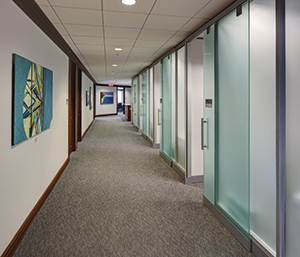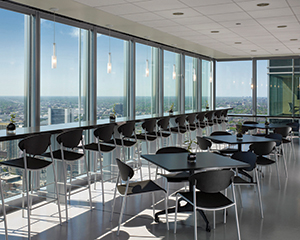Law firms say goodbye to corner offices; hello to open, collaborative designs
By: Erika Strebel, [email protected]//June 8, 2017//
Law firms say goodbye to corner offices; hello to open, collaborative designs
By: Erika Strebel, [email protected]//June 8, 2017//


In the 25 years Pat Algiers has been designing law offices, she has seen plenty of change.
For one, firms no longer necessarily put lawyers who have moved up in the ranks in larger office spaces, said the president of the Shorewood-based design firm Chemistry in Place. Rather than having offices of three or four different sizes, firms are providing lawyers — no matter their seniority or partner status — with essentially the same accommodations.
Whether you’re a partner or an associate, your office is likely to be close to 10-feet-by-15-feet.
Much of the change has been driven by economic considerations — the less space a firm leases, the lower its expenses.
In another change Algiers has seen, lawyers are tending to work more closely with their employees. Workspaces have accordingly been adapted. Many law offices, for instance, now have conference rooms designed specifically to let partners work collaboratively with their teams.
Still other physical changes have been meant to imbue offices with an atmosphere of openness and accessibility. One result has been a greater reliance on glass as a building component.
Amidst all the change, one constant has been the emphasis placed on choosing the right location for a law office. It’s one of the first things Algiers says firm officials should think about if they’re considering a move or redesign of their office space.
“Location is everything,” Algiers said. “Multiple age groups, not just millennials, want to work in a city or live in a city. So a downtown area, regardless of the size of town, seems more often than not to be the most desired location for a law firm to be.”
But all the satisfaction that firm officials might get out of new furniture or a move to a new place should take a backseat to one looming consideration: The terms of their rental agreement.
“They should think about how many years out they are signing a lease,” Algiers said. “They should not be short-sighted. If it’s a 10-year lease, they’ve got to stretch themselves to say what’s appropriate 10 years out so that their space does not become obsolete.”
This often means taking a hard look at a firm’s brand and thinking about how it could be complemented by current trends in design and architecture. That’s why, before drawing up plans, Algiers and her team spend as much time as possible learning about a particular client.

“Every firm is different,” she said. “They’re different because of say the type of law, the type of personality, the culture. And in order to say the design is accessible, you have to be able to say that it both looks and feels like the firm. It can’t come off as generic. It has to come off so you can read the personality of the firm.”
John Peterburs, executive director at Quarles & Brady, noted that firms must also consider clients’ needs and expectations.
“I think clients want to see your space as efficient and practical, not something that’s very opulent and just over the top in terms of furnishings and spending,” Peterburs said.
In addition to taking a hard look at their brand and identity, firms must also try to peer into the future. This can mean everything from trying to gauge the expectations of future recruits to attempting to foresee what sorts of technological advances might come along and prove useful.
“It’s so hard to predict with people’s work habits changing and technology,” Peterburs said. “People are working more from home, they’re working more remotely. There isn’t as much emphasis on their office workspace, and they don’t bring clients to their office anymore like they once did. They bring them to central reception areas.”
One way to adapt to the changes, Peterburs said, is to use open spaces that lend themselves to reconfiguration and modular designs.
Still, Algiers, who has designed various Quarles & Brady offices throughout the country, cautioned that only so much can be accomplished with an office’s layout. Even with the best designs, she said, change is seldom easy.
“Sometimes it’s really hard to let go of how they work, how space is laid out, but everything about the way in which we work is changing,” Algiers said. “They cannot be change-adverse. They need to look to the future, to crystal ball it and take their best guess on how space works together and how space would be laid out as appropriate for their practice.” Follow @erikastrebel
Legal News
- Former law enforcement praise state’s response brief in Steven Avery case
- Eric Toney announces re-election bid for Fond du Lac County District Attorney
- Former Wisconsin Democratic Rep. Peter Barca announces new bid for Congress
- Republicans file lawsuit challenging Evers’s partial vetoes to literacy bill
- More human remains believed those of missing woman wash up on Milwaukee Co. beach
- Vice President Harris returning to Wisconsin for third visit this year
- Wisconsin joins Feds, dozens of states to hold airlines accountable for bad behavior
- Trump ahead of Biden in new Marquette poll
- Bankruptcy court approves Milwaukee Marriott Downtown ‘business as usual’ motion
- New Crime Gun Intelligence Center to launch in Chicago
- Arrest warrant proposed for Minocqua Brewing owner who filed Lawsuit against Town of Minocqua
- Wisconsin Supreme Court justices question how much power Legislature should have
WLJ People
- Power 30 Personal Injury Attorneys – Russell Nicolet
- Power 30 Personal Injury Attorneys – Benjamin Nicolet
- Power 30 Personal Injury Attorneys – Dustin T. Woehl
- Power 30 Personal Injury Attorneys – Katherine Metzger
- Power 30 Personal Injury Attorneys – Joseph Ryan
- Power 30 Personal Injury Attorneys – James M. Ryan
- Power 30 Personal Injury Attorneys – Dana Wachs
- Power 30 Personal Injury Attorneys – Mark L. Thomsen
- Power 30 Personal Injury Attorneys – Matthew Lein
- Power 30 Personal Injury Attorneys – Jeffrey A. Pitman
- Power 30 Personal Injury Attorneys – William Pemberton
- Power 30 Personal Injury Attorneys – Howard S. Sicula











